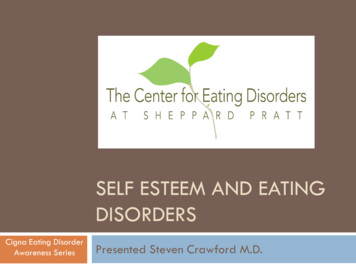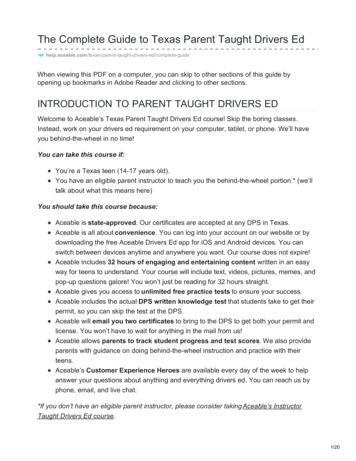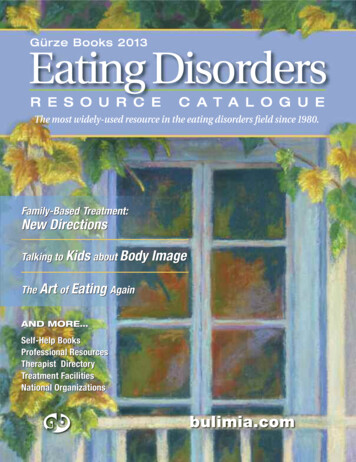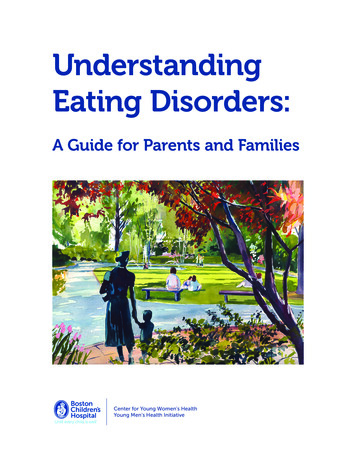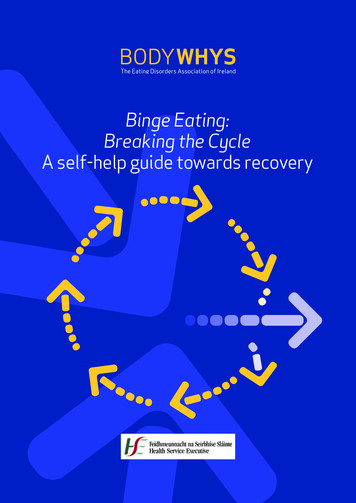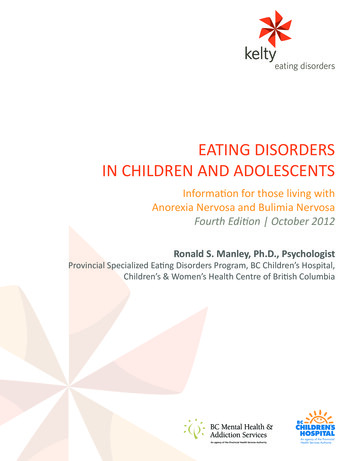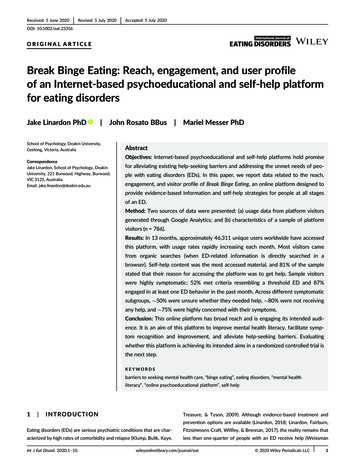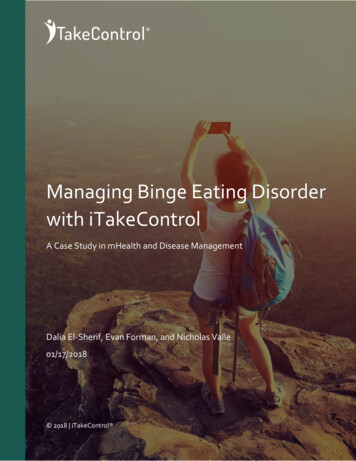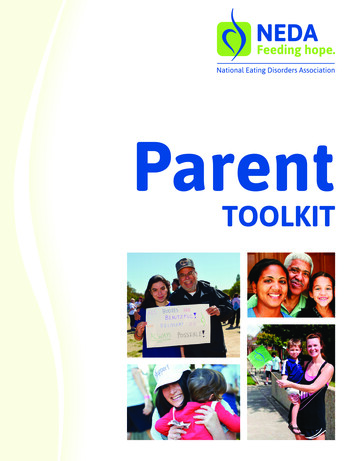
Transcription
ParentTOOLKIT
NEDA TOOLKIT for ParentsTable of ContentsI.The NEDA Educational Toolkits Story. 3II.About Eating Disorders. 5Eating Disorder MythsRisk Factors for Eating DisordersEmotional and Behavioral Signs of an Eating DisorderPhysical Signs and Symptoms of an Eating DisorderEating Disorder StatisticsIII.Supporting a Loved One. 16Encouraging a Loved One to Seek HelpEncouraging Your Child to Seek TreatmentFirst Steps to Getting HelpHow to Support a Loved One with an Eating DisorderHow to Talk to a Loved One about an Eating DisorderTalking to Young Children About Eating DisordersWhen Your Loved One is Over 18 and Refusing TreatmentIV.2730363740Insurance Issues. 43Understanding Insurance Issues for Eating Disorders TreatmentObtaining Insurance Benefits for Higher Levels of CareCommon Reasons for Denying Further CareSteps to Take When Determining Coverage AllowancesStrategies for Providers for Fighting Insurance DenialHow to Manage an Appeals ProcessSample Letters to Use with Insurance CompaniesOther Steps for Loved OnesVI.17182021222324Treatment Information. 26Level of Care Guidelines for PatientsFinding Treatment for Your Loved One’s Eating DisorderQuestions to Ask a Treatment Provider PrivatelySelecting a Treatment Center for Your Loved OneTreatment GlossaryV.6101112144447484950525363Making Sense of Neuroscience . 64AppetiteBody ImageNeurotransmittersRewardTemperament and Personality6567697274Page 2
NEDA TOOLKIT for ParentsThe NEDA Educational Toolkits StoryThe BackgroundWhen a friend or family member is diagnosed with aneating disorder, it’s often terrifying and confusing. Howdid this happen to our family? Is my child going to beokay? Will my friend ever get better? It’s all too easy toget tangled in these questions and become mentallytrapped, paralyzed with fear and unable to helpyourself — or your loved one.Of course, no toolkit, no matter how thorough, couldpossibly address the diverse range of issues that areunique to each individual and family. Instead, ourgoal is to provide a comprehensive overview of eatingdisorders and treatment in one easy-to-use document.We have provided resources for more in-depthinformation that may address these unique issues.Helping your loved one recover from an eating disorderwill take a lot of work from everyone involved. Aswith many jobs, having the right tools is crucial. Eatingdisorders have a steep learning curve, and you and yourfamily member will need to develop lots of tools towork towards recovery.Our goal is to maintain the usefulness of the toolkitsby treating them as ever-evolving documents. We willcontinue reviewing and revising them, adding the mostup-to-date research and information. NEDA’s clinicaladvisors will be the primary reviewers, along with otherexperts and stakeholders invited by NEDA, includingfamilies and members of professional organizations thatwill be disseminating the toolkits. If you have suggestionsfor improvement, we want to hear from you!The NEDA Parent Toolkit was created to provide someof these tools that can be used in critical moments inyour search for help, hope and healing. As one parenttold us, “this toolkit was exactly the resource weneeded when we started the journey for our family, weneeded real resources, reassurance that we were notthe only family with the challenge and that there wouldbe light at the end of that tunnel.” The toolkits aredesigned to put crucial information at your fingertipsand offer your family a range of ideas on how to besthelp your loved one recover from an eating disorder.Some of the questions you might find answered in thefollowing pages are: What are eating disorders and how are theytreated?What are signs of a medical or psychiatricemergency?How do I deal with school issues while my childis ill?What types of treatment are available?How do I know what type of treatment will workbest?How do I get my insurance company to cover myloved one’s treatment?A Brief History of the ToolkitsIn September 2007 the Board of Directors of NEDAofficially approved the organization’s new strategicpriorities, listing educational toolkits as a new NEDApriority fitting the new mission: “To support thoseaffected by eating disorders and be a catalyst forprevention, cures, and access to quality care.”Educational Toolkits were created to strengthenNEDA’s online material offerings and provide vitalinformation to targeted audiences. A list of audienceswas prioritized by the board and serves as a referencefor ongoing materials and toolkit development.The toolkits were initially developed to combineexisting information with new findings to create acomplete package to assist individuals in their searchfor information and help. They were meant to provideguidance, not create standards of care, and would bebased on the best available information at the time ofdevelopment.Page 3
NEDA TOOLKIT for ParentsThe first toolkits were created with the assistanceof the ECRI Institute, an organization known for itsability to translate complex healthcare research intoaccessible, usable information. After developingthe first draft of the Parent Toolkit, NEDA and ECRIconvened several focus groups of parents to review thedocument. Together with input from NEDA’s Board ofDirectors and other eating disorders experts, the firstParent Toolkit was released in 2008. A revised ParentToolkit was released two years later.We are currently seeking funding for the ongoingdevelopment of toolkits, as well as distributionand marketing. If you or anyone you know may beinterested in contributing to, sponsoring or providinga grant to support these efforts, please be sure tocontact our Development Office at 212-575-6200, ext.307; development@nationaleatingdisorders.org.We hope you’ll find these toolkits useful and will sharethis resource with others.With the continuing advances in eating disorderresearch and treatment, NEDA realized that anothermore significant revision was needed. Again, the inputof parents, former eating disorder sufferers, and eatingdisorder experts was used to further refine the draftdocument. In 2015, version 3.0 of the Parent Toolkitwas released.Page 4
NEDA TOOLKIT for ParentsAbout EatingDisordersPage 5
NEDA TOOLKIT for ParentsEating Disorder MythsEven for professionals who have been treating them for years, eating disorders can be baffling and confusingillnesses. Adding to this confusion is the fact that eating disorders are surrounded by a large number of myths andmisconceptions. It can be difficult for some people to take an eating disorder diagnosis seriously. This section willhelp dispel some of the most common misunderstandings about eating disorders and those affected by them.You may wish to print out this section and share it with others (other family members, friends, teachers, coaches,physicians, etc.).Eating disorders are a choice. I just need totell my loved one to snap out of it.Eating disorders (EDs) are actually complex medicaland psychiatric illnesses that patients don’t chooseand parents don’t cause. The American PsychiatricAssociation classifies five different types of eatingdisorders in the Diagnostic and Statistical Manual, 5thEdition (DSM-5): Anorexia Nervosa, Bulimia Nervosa,Binge Eating Disorder (BED), Avoidant Restrictive FoodIntake Disorder (ARFID) and Other Specified Feedingor Eating Disorder (OSFED). Several decades of geneticresearch show that biological factors play a significantrole in who develops an eating disorder. EDs commonlyco-occur with other mental health conditions like majordepression, anxiety, social phobia, and obsessivecompulsive disorder.Doesn’t everyone have an eating disorderthese days?Although our current culture is highly obsessed withfood and weight, and disordered patterns of eatingare very common, clinical eating disorders are less so.A 2007 study asked 9,282 English-speaking Americansabout a variety of mental health conditions, includingeating disorders. The results, published in BiologicalPsychiatry, found that 0.9% of women and 0.3% ofmen had anorexia during their life, 1.5% of women and0.5% of men had bulimia during their life, and 3.5% ofwomen and 2.0% of men had binge eating disorderduring their life. The consequences of eating disorderscan be life-threatening, and many individuals find thatstigma against mental illness (and eating disordersin particular) can obstruct a timely diagnosis andadequate treatment.Eating disorders are a choice.The causes of an eating disorder are complex. Currentthinking by eating disorder researchers and clinicalexperts holds that eating disorders are caused byboth genetic and environmental factors; they arebio-sociocultural diseases. A societal factor (like themedia-driven thin body ideal) is an example of anenvironmental trigger that has been linked to increasedrisk of developing an eating disorder. Environmentalfactors also include physical illnesses, childhood teasingand bullying, and other life stressors. Historical datareveals that some of the earliest documented casesof eating disorders were associated with religiousfasting. Additionally, they may run in families, as thereare biological predispositions that make individualsvulnerable to developing an eating disorder.I need to figure out what I did to cause mychild’s eating disorder.Organizations from around the world, includingthe Academy for Eating Disorders, the AmericanPsychiatric Association, and NEDA, have publishedguidelines which indicate that parents don’t causeeating disorders. Parents, especially mothers, weretraditionally blamed for their child’s disorder, butmore recent research supports that eating disordershave a strong biological root. Eating disorders developdifferently for each person affected, and there is not asingle set of rules that parents can follow to guaranteeprevention of an eating disorder, however there arethings everyone in the family system can do to play arole in creating a recovery-promoting environment.Psychologists have seen improvements in the speed atwhich children and adolescents begin to recover whenincluding parents in the treatment process.It’s just an eating disorder. That can’t be a bigdeal.Eating disorders have the highest mortality rate of anypsychiatric illness. Up to 20% of individuals with chronicanorexia nervosa will die as a result of their illness.Community studies of anorexia, bulimia, and eatingdisorder not otherwise specified (EDNOS, now calledOSFED) show that all eating disorders have similarmortality rates. Besides medical complications frombinge eating, purging, starvation, and over-exercise,suicide is also common among individuals with eatingdisorders. People who struggle with eating disordersalso have a severely impacted quality of life.Page 6
NEDA TOOLKIT for ParentsAnorexia is the only serious eating disorder.When researchers examined the death rates ofindividuals with any eating disorder diagnosis who werebeing treated as outpatients, they found that bulimiaand EDNOS (now OSFED) had mortality rates thatapproached the high rates seen in anorexia nervosa.During the study, roughly 1 in 20 people with eatingdisorders died as a result of their illness. Individualswho abuse laxatives or diuretics or force themselves tovomit are at significantly higher risk of sudden deathfrom heart attacks due to electrolyte imbalances.Excessive exercise also can increase the risk of deathin individuals with eating disorders by increasing theamount of stress on the body.Since I don’t see my loved one engaging ineating disordered behaviors, I don’t need toworry about them.Many eating disorder sufferers go out of their way tohide symptoms of their illness, either out of shame orbecause they are afraid someone will make them stop.It’s not uncommon for loved ones to be caught offguard at how severe and pervasive the eating disorderbehaviors are when a diagnosis is made or when peopleclose to the sufferer become aware they are struggling.If you are aware a loved one is struggling it is importantto express concern, with empathy and compassion, andencourage the individual to seek help.My loved one isn’t ready to recover from theireating disorder, and there’s nothing I can dountil they are.Some eating disorder sufferers have difficulty recog nizing that they are ill or appreciating the severity oftheir situation. Still others may desperately want tostop their behaviors but are afraid. While expressinga readiness and willingness to recover is a positivesign, treatment doesn’t need to wait for your lovedone to be ready. If your loved one is under the ageof 18, and even if they aren’t, it is crucial to begintreatment as soon as you are aware of the problem.Early intervention is consistently associated with higherrecovery rates. If the individual struggling is an adult,family and friends should continue to express concernsabout the negative impact of the eating disorder ontheir loved one’s life and encourage him/her to seekprofessional help.As a parent, there’s not much I can do to helpmy child recover.Research continues to consistently find the opposite istrue: parental involvement in a child’s eating disordertreatment can increase chances of recovery. Someforms of treatment, like Family-Based Treatment (FBT)(also known as the Maudsley Method), require thatparents temporarily take control of the child’s eatingand monitor for purging until a healthy weight andregular eating patterns are established. Other lovedones can continue to provide support to the eatingdisorder sufferer by helping to reduce anxiety overeating and reminding them they are more than theirillness. Even if you decide FBT isn’t right for your family,there are still plenty of ways for you to be involved inyour child’s or loved one’s treatment.My family member won’t recover until theyuncover the reason they developed theireating disorder.While some people can point to a reason or eventthat they believe caused their eating disorder, plentyof people with eating disorders don’t have a specificreason. Nor is there any evidence that uncovering thecause of an eating disorder is correlated with recovery.Regardless of why someone may have developedan eating disorder, generally the first priorities oftreatment are to restore normal eating and weight.If my loved one insists they are fine, I shouldbelieve them.Problems with accurate self-awareness are one of thehallmarks of EDs, so your loved one may not have theself-awareness required to recognize a problem. Thus,the individual struggling may genuinely believe they arefine when they are acutely ill. Other people may denythe presence of an eating disorder even when theyknow they are ill because they are afraid of treatment.Regardless of the reason, it is important to insist ontreatment by a trained mental health professionaland regular medical follow-up with a physician who iswell-versed in eating disorders. (See page 20 for moreinformation on medical tests.)Page 7
NEDA TOOLKIT for ParentsStrict rules about eating or fad diets aren’t aproblem.What appears to be a strict diet on the surface mayactually be the beginning of an eating disorder. Evenif the symptoms do not meet the criteria for a clinicaleating disorder diagnosis, disordered eating can haveserious medical consequences, such as anemia andbone loss. Individuals dealing with serious disorderedeating may benefit from intervention and treatment toaddress their concerns before it becomes a full-blowneating disorder. Chronic dieting has been associatedwith the later development of an eating disorder, soaddressing these issues right away may prevent a fullblown eating disorder.As long as someone isn’t emaciated, they arenot that sick.Most people with an eating disorder are not under weight. Although most people with eating disordersare portrayed by the media as emaciated, you can’ttell whether someone has an eating disorder just bylooking at them. These perceptions can perpetuatethe problem and may cause distress in eating disordersufferers for fear of not being “sick enough” or “goodenough” at their disorder to deserve treatment.Additionally, you cannot determine if an individual isstruggling with binge eating disorder (BED) based ontheir weight. It is important to remember that justbecause a sufferer is no longer emaciated, or has lostweight in the process of treatment for BED, it doesn’tmean they are recovered; an individual can experiencea severe eating disorder at any weight.The main eating disorder symptom I have toworry about in my loved one is weight loss.Although anorexia nervosa and other restrictive eatingdisorders are characterized by weight loss, manypeople with eating disorders don’t lose weight andmay even gain weight as a result of their disorder.Eating disorder behaviors only focus on food.Individuals with eating disorders generally have anunhealthy focus on food and weight, but the symptomsof an eating disorder can extend far beyond food.Numerous scientific studies have shown links betweeneating disorders, perfectionism, and obsessionality,which can lead to a fixation on grades, sportsperformance, etc. Although many sufferers report thateating disorder behaviors initially help them decreasedepression and anxiety, as the disorder progresses, themalnutrition caused by eating disorder behaviors canultimately increase the levels of depression and anxietythat can affect all aspects of life.My loved one doesn’t claim to feel fat. Canthey still have an eating disorder?Absolutely. Body image distortions are very commonin eating disorders, but they are far from universal.Clinical reports indicate that young children are muchless likely to have body image disturbance, and plentyof teens and adults also don’t report this symptom.Since eating disorders are linked to biology,my loved one doesn’t have much hope forrecovery.It’s important to remember that biology isn’t destiny.There is always hope for recovery. Although biologicalfactors play a large role in the onset of EDs, they are notthe only factors. The predisposition towards disorderedeating behaviors may reappear during times of stress,but there are many good techniques individuals witheating disorders can learn to help manage their emotionsand keep behaviors from returning.I have a son. I don’t have to worry about eatingdisorders because they’re a “girl thing.”Eating disorders can affect anyone, regardless of theirgender or sex. Although eating disorders are morecommon in females, researchers and clinicians arebecoming aware of a growing number of males whoare seeking help for eating disorders. A 2007 study bythe Centers for Disease Control and Prevention foundthat up to one-third of all eating disorder sufferers aremale. It’s currently not clear whether eating disordersare actually increasing in males or if more maleswho are suffering are seeking treatment or beingdiagnosed. Because physicians don’t often think thateating disorders affect males, their disorders havegenerally become more severe and entrenched at thepoint of diagnosis. There may be subtle differencesin eating disorder thoughts and behaviors in males,who are more likely to be focused on building musclethan on weight loss. They are also more likely to purgevia exercise and misuse steroids than females are.Although gay, bisexual, and transgender males aremore likely to develop an eating disorder than straightmales, the vast majority of male eating disordersufferers are heterosexual.Page 8
NEDA TOOLKIT for ParentsMy child is too young to develop an eatingdisorder.My son has bulimia, so he won’t developanother type of eating disorder.Eating disorders can develop or re-emerge at any age.Eating disorder specialists are reporting an increasein the diagnosis of children, some as young as five orsix. Many eating disorder sufferers report that theirthoughts and behaviors started much earlier thananyone realized, sometimes even in early childhood.Picky eating is common in young children, but doesn’tnecessarily indicate an eating disorder. Although mostpeople report the onset of their eating disorder in theirteens and young adulthood, there is some evidencethat people are being diagnosed at younger ages. It’snot clear whether individuals are actually developingeating disorders at younger ages or if an increasedawareness of eating disorders in young children has ledto improved recognition and diagnosis.Many with eating disorders will suffer from more thanone disorder before they ultimately recover. Roughlyhalf of all people with anorexia will go on to developbulimia. Some individuals show signs of both anorexiaand bulimia simultaneously, regularly binge eatingand they may also purge while at a low weight (thisis clinically classified as anorexia, binge/purge type).Still others transition from one diagnosis to another, aprocess known as diagnostic cross-over. All may involvelife-threatening consequences.Now that my loved one is no longer a teenager,I don’t have to worry about an eating disorder.They’ll grow out of it.People can struggle with an eating disorder regardlessof their age. Research literature has identified asubset of people with eating disorders who seem torecover spontaneously, without treatment. However,many people who struggle with eating disorders anddisordered eating in their teens continue to struggleinto adulthood unless they receive treatment. Men andwomen at midlife and beyond are being treated foreating disorders, either due to a relapse, ongoing illnessfrom adolescence or young adulthood, or due to thenew onset of an eating disorder.I’m not worried about my friend becauseeveryone eats too much ice cream sometimes.Everyone must have binge eating disorder.Binge eating disorder only affects 3.5% of women,2% of men and up to 1.6% of adolescents, and it isnot the same thing as occasionally eating more thanis comfortable. Those who are struggling with bingeeating disorder engage in recurring episodes – at leastonce per week over three months – in which they eatsignificantly more food in a short space of time thanmost people would, and experience a sense of loss ofcontrol over their eating behavior. The frequency andseverity of the disorder have a significantly negativeimpact on the individual’s life, with many sufferersexperiencing co-occurring conditions such as majordepression and anxiety.Purging only involves self-induced vomiting.Purging includes any method of removing food fromthe body before it is fully digested. Many times, anindividual is driven to purge to compensate for whatwas perceived as excessive food intake. While selfinduced vomiting is one of the most common ways thatan individual will purge, it’s far from the only method.Individuals can also use laxatives and enemas, as wellas use non-purging compensatory behaviors, suchas abusing insulin, fasting, and excessive exercising.Individuals can also purge by using more than onemethod. Each method carries its own particular risks,but all involve potentially life-threatening electrolyteimbalances.Once my daughter with anorexia gains weight,she will be fine.Weight and nutritional restoration are only the firststeps to anorexia recovery. Once an anorexia suffererhas returned to a weight that is healthy for them, theycan usually participate more fully and meaningfullyin psychotherapy. Other psychological work usuallyneeds to be done so the person can manage difficultemotions without resorting to anorexic behaviors.Weight recovery alone does not mean the eatingdisorder is cured.Page 9
NEDA TOOLKIT for ParentsRisk Factors for Eating DisordersEating disorders are complex conditions that can arise from a combination of long-standing behavioral, biological,emotional, psychological, interpersonal, and social factors. Once started, however, they can create a selfperpetuating cycle of physical and emotional destruction.Although scientists are still investigating the factors that can contribute to the development of an eating disorder,they have identified some risk factors for the development of an eating disorder.Psychological Risk Factors PerfectionismAnxietyDepressionDifficulties regulating emotionObsessive-compulsive behaviorsRigid thinking style (only one right way to dothings, etc.)Sociocultural Risk FactorsBiological Risk Factors Having a close family member with an eatingdisorderFamily history of depression, anxiety, and/oraddictionPersonal history of depression, anxiety, and/oraddictionPresence of food allergies that contribute topicky or restrictive eating (e.g. celiac disease)Presence of Type 1 Diabetes Cultural promotion of the thin ideal Size and weight prejudice Emphasis on dieting “Ideal bodies” include only a narrow range ofshapes and sizesPage 10
NEDA TOOLKIT for ParentsEmotional and Behavioral Signs of an Eating DisorderThose struggling with an eating disorder may have some, but not all, of the following emotional and behavioralsigns. Presence of any of the signs that your loved one may be struggling is cause for serious concern and youshould encourage them to seek professional help. Intense fear of gaining weightNegative or distorted self-imageFrequent checking in the mirror for perceivedflawsSelf-worth and self-esteem dependent on bodyshape and weightFear of eating in public or with othersPreoccupation with foodEating tiny portions or refusing to eatAvoiding eating with othersHoarding and hiding foodEating in secretDisappearing after eating — often to thebathroomUnusual food rituals (cutting food into smallpieces, chewing each bite an unusually largenumber of times, eating very slowly)Any new practice with food or fad diets,including cutting out entire food groups (nosugar, no carbs, no dairy, vegetarianism/veganism)Little concern over extreme weight loss Obessive interest in cooking shows ontelevision and collecting recipesConsumption of only “safe” or “healthy” foodsSocial withdrawalMaking excuses for not eatingCooking elaborate meals for others, butrefusing to eat them themselvesEating strange combinations of foodsElaborate food ritualsWithdrawing from normal social activitiesHiding weight loss by wearing bulky clothesFlat mood or lack of emotionIrritabilityMood swingsHyperactivity and restlessness (unable to sitdown, etc.)Rigidity in behaviors and routines, andexperience of extreme anxiety if these areinterruptedExcessive exercisingExercising even when ill or injured, or for thesole purpose of burning caloriesIndividuals with eating disorders may be at risk for co-occurring conditions such as mood and anxiety disorders,substance abuse (alcohol, marijuana, cocaine, heroin, methamphetamines, etc.), self-harm (cutting, etc.) andsuicidal thoughts and behaviors.Page 11
NEDA TOOLKIT for ParentsPhysical Signs and Symptoms of an Eating DisorderThose struggling with an eating disorder may have some, but not all, of the following physical signs and symptoms.Presence of any of the signs that your loved one may be struggling is cause for serious concern and you shouldencourage them to seek professional help. Noticeable fluctuations in weight, both up anddownStomach cramps, other non-specificgastrointestinal complaints (constipation, acidreflux, etc.)Menstrual irregularities — missing periodsor only having a period while on hormonalcontraceptives (this is not considered a “true”period)Difficulties concentratingAbnormal laboratory findings (anemia, lowthyroid and hormone levels, low potassium,low blood cell counts, slow heart rate)DizzinessFainting/syncopeFeeling cold all the timeSleep problemsCuts and calluses across the top of finger joints(a result of inducing vomiting) Dental problems, such as enamel erosion,cavities, and tooth sensitivityDry skinDry and brittle nailsSwelling around area of salivary glandsFine hair on bodyThinning of hair on head, dry and brittle hair(lanugo)Cavities, or discoloration of teeth, fromvomitingMuscle weaknessYellow skin (in context of eating large amountsof carrots)Cold, mottled hands and feet or swelling of feetPoor wound healingImpaired immune functioningSigns of Anorexia Nervosa Dramatic weight lossDresses in layers to hide weight loss or staywarmIs preoccupied with weight, food, calories, fatgrams, and dietingRefuses to eat certain foods, progressing torestrictions against whole categories of food(e.g., no carbohydrates, etc.)Makes frequent comments about feeling “fat”or overweight despite weight lossComplains of constipation, abdominal pain,cold intolerance, lethargy, and excess energyDenies feeling hungryDevelops food rituals (e.g., eating foods incertain orders, excessive chewing, rearrangingfood on a plate)Cooks meals for others without eatingConsistently makes excuses to avoid mealtimesor situations involving foodMaintains an excessive, rigid exercise regimen– despite weather, fatigue, illness, or injury, theneed to “burn off ” calories taken in Withdraws from usual friends and activitiesand becomes more isolated, withdrawn, andsecretiveSeems concerned about eating in publicHas limited social spontaneityResists maintaining a body weightappropriate for their age, height, and buildHas intense fear of weight gain or being“fat,” even though underweightHas disturbed experience of body weightor shape, undue influence of weight orshape on self-evaluation, or denial of theseriousness of low body weightPostpuberty female loses menstrual periodFeels ineffectiveHas strong need for controlShows inflexible thinkingHas overly restrained initiative andemotional expressionPage 12
NEDA TOOLKIT for ParentsSigns of Bulimia Nervosa
Binge Eating Disorder (BED), Avoidant Restrictive Food Intake Disorder (ARFID) and Other Specified Feeding or Eating Disorder (OSFED). Several decades of genetic research show that biological factors play a significant role in who develops an eating disorder. EDs commonl
